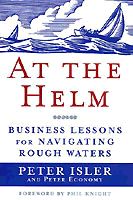 |
| ||||||||||||||||
 |
At the Helm : Business Lessons for Navigating Rough WatersPeter Isler and Peter Economy
Excerpt At the HelmThere are days on the racecourse when you feel like mother nature is reaching deep and throwing her best stuff at you. That was the case during the fifth race of the Challenger Finals for the 1987 America's Cup. As part of Dennis Conner's Stars & Stripes team, we had prepared for this day for years, training aboard a series of sixty-five-foot aluminum-hulled sloops in the blustery northeast trade winds off Oahu's south coast, testing ourselves and our boats in conditions that most sailors would consider extremely dangerous. I was on the boat as the navigator, along with tactician Tom Whidden. Dennis was on the helm, and we had a crew of eight other sailors. Another day of twenty-four to twenty-eight-knot winds shouldn't have seemed so tough, but for some reason it did that particular day. Maybe it had something to do with the competition. Chris Dickson's team aboard the New Zealand challenger, Kiwi Magic, had been dominant throughout the three months of trials, losing only once and racking up thirty-seven wins. But the slate had been wiped clean, and we were well into the best-of-seven series. The first team to win four races would earn a shot at the defending Aussies in the America's Cup Match. The losing team would go home--tens of millions of dollars poorer--without so much as a wooden plaque to remember the race by. In the America's Cup, there is no second place. As the twenty-five-ton sloop pounded upwind in the choppy three- to five-foot waves off Fremantle, Australia, viewers from around the world were tuned in--watching the spectacle live on television. The boat looked part submarine, part sailboat as it sliced through the seas. Stars & Stripes had opened up a ten-boat-length lead over the Kiwis when all of a sudden . . . Bang! The headsail, made out of ultrastrong Kevlar fibers, exploded--torn to shreds by the combined force of wind and waves. Where once there had been a smooth, wing-shape foil helping to drive the sloop forward, now there were only tatters waving dangerously from the rigging like some long-forgotten flag. Even from the comfort of a living room several thousand miles away, the next few moments were dramatic--certainly the most memorable moments of the 1987 America's Cup campaign. It was an all-hands-on-deck emergency as eight of the eleven crew members raced up to the foredeck to help pull in the remnants of the sail and quickly get them out of the way. On the pitching foredeck, the old expression, "one hand for yourself and one hand for the ship" took on new meaning. Unlike a standard ocean-racing sailboat, a 12 Meter has no guardrails--just keeping your balance up there is a very real and ongoing challenge. If you're careless or lose your concentration for just a moment, there's nothing to keep you from washing into the Indian Ocean. Add to that the task of wrestling a savage wind to get a sail under control and stuffed down below--all the while holding on for dear life--and it's downright insane! A sailboat can be an incredibly inhospitable place to be. When the seas are churning, and the wind is howling, keeping "one hand for yourself and one hand for the ship" can literally mean the difference between life and death. While few of us are faced with such extreme conditions at work, we are often faced with situations that can make the difference between getting the promotion or recognition we've been long striving for and deserve, or not. Just as on a sailboat, you should keep one hand for yourself--learning new skills, taking on new responsibilities, and promoting your own interests--and one hand for the organization. By focusing your efforts on both fronts, you ensure that your organization, your coworkers and clients will receive maximum benefit from your efforts-and you will optimize your personal performance. Somehow, we managed to get the one-thousand-plus square feet of bulletproof sailcloth stuffed through the hatch and out of the way down below. If you have ever felt the "fabric" of a modern racing sail, you know that it has a texture much closer to a sheet of light aluminum than to a sheet of cotton. To gather the sail you must somehow get a grasp on this slippery surface, drag it in a few feet, and then reach up and do it again. And all the while you are using every ounce of your strength to pull the sail against the wind--somehow staying glued to a tiny, wet, and slippery foothold. A few feet away from you, a teammate is doing the same thing, and inch by inch you make progress. As we dragged in the blown-out sail, our boat slowed from 8.5 knots to less than half of its racing speed. Kiwi Magic was closing fast as we stuffed the last remnants of the old sail below, and Scotty Vogel prepared a new sail for hoisting. During this time, the bow of the boat was plunging up and down--going through more than ten feet of vertical motion. A split-second of inattention to the boat, or just a bit of bad luck, and one or more of us could have been launched off the bow and into the choppy seas, endangering the other crew members and putting the last nail in the coffin of this particular race. Fortunately for us, the story had a happy ending. We were able to hoist the new sail before Dickson and his crew could get past us. As the new sail filled and we started picking up speed, you could almost hear the cheers and applause from the millions of TV viewers around the world who had just been treated to one of the most exciting moments in America's Cup history--live! We went on to win the series four races to one and move on to the America's Cup where we found the Aussies were less competitive than the Kiwis. We won the Cup in four straight races and headed home with our trophy to a reception at the White House and a ticker-tape parade down Fifth Avenue. That moment was certainly a major milestone in our campaign, but the real story started about a week before that when, in training, we had a similar all-hands-on-deck emergency during a practice race with the British team. The conditions at that time were far milder (it was only blowing eighteen knots that day!), but the same group of guys completely whiffed on the recovery. We got the old sail so tangled up on the foredeck that there was no hope of hoisting a new one. Dennis finally headed off the course in disgust over his so-called "professional" crew's inability to solve the problem. |
|||||||||||||||||||||
|
All prices subject to change and given in U.S. Dollars. |
All materials contained in http://www.LeadershipNow.com are protected by copyright and trademark laws and may not be used for any purpose whatsoever other than private, non-commercial viewing purposes. Derivative works and other unauthorized copying or use of stills, video footage, text or graphics is expressly prohibited. LeadershipNow is a trademark of M2 Communications, LLC. |
